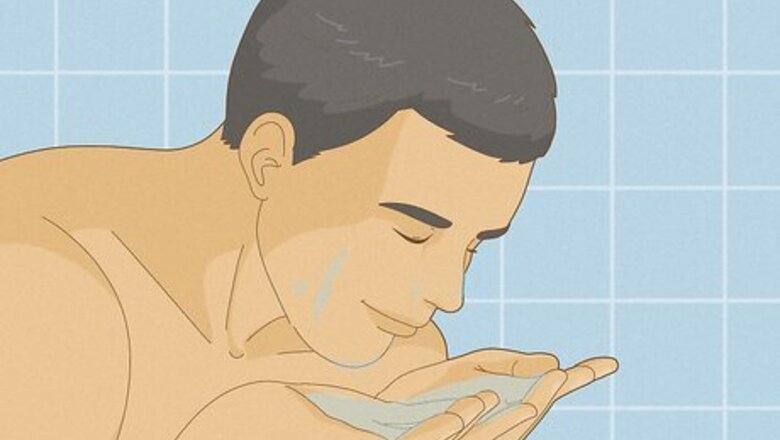
views
Using Daily Cleansing Techniques
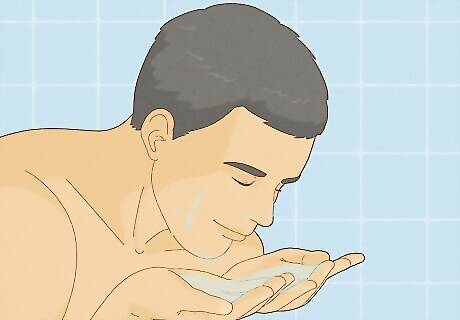
Wash your face twice daily. Keeping your face clean is the best way to ensure that your face is free of pimples and other imperfections. Wash your face once in the morning and once at night as well as any time your face is sweaty. For example, it is a good idea to wash your face before and after a workout or after you have been doing physical labor. Try keeping some cleansing wipes in your gym bag or purse that you can use to wipe off your makeup and cleanse your skin. Wet your face with lukewarm water to start. You can simply bend over a sink and splash some lukewarm water on your face.

Use your fingertips to apply gentle cleanser. It is best to wash your face with a gentle cleanser. Apply a small amount of the cleanser to your hands and use your hands and fingertips to massage the cleanser into your skin. Make sure that you close your eyes to avoid getting cleanser in them. If you prefer to use a cloth, use a gentle cotton washcloth to massage the cleanser into your skin. Avoid scrubbing because this can irritate your skin. EXPERT TIP Paul Friedman, MD Paul Friedman, MD Board Certified Dermatologist, American Board of Dermatology Paul Friedman, MD, is a Board-Certified Dermatologist, and the Director and Founder of the Dermatology & Laser Surgery Center in Houston, Texas. He has over 25 years of experience and specializes in Mohs micrographic surgery, dermatologic laser surgery, and cosmetic dermatology. Dr. Friedman is the current President of the American Society for Laser Medicine & Surgery and was named by Newsweek Magazine as one of the Best Dermatologists in America for Laser Treatments. His awards include the Husk Prize for his research in dermatologic surgery and the Young Investigator's Writing Competition Award of the American Society for Dermatologic Surgery. Dr. Friedman completed his dermatology residency at the New York University School of Medicine and received his medical degree with the highest honors from the University of Tennessee Health Science Center, College of Medicine. Paul Friedman, MD Paul Friedman, MD Board Certified Dermatologist, American Board of Dermatology Our Expert Agrees: Don't use cleansers that use abrasive or rough ingredients to cleanse your face. This would include scrubs that have silica beads or crushed seeds and nuts (like apricot or almond), which can irritate your face.

Rinse with lukewarm water. When you have finished applying the cleanser, splash some lukewarm water onto your face to rinse it away. Do this several times to ensure that you have completely rinsed off the cleanser. You can also use a clean wash cloth to help remove the cleanser. Just avoid rubbing and scrubbing with the cloth. Instead, apply the wet cloth to your face and gently wipe away the cleanser. After you have completely removed the cleanser, turn the water to cool and splash your face with it.
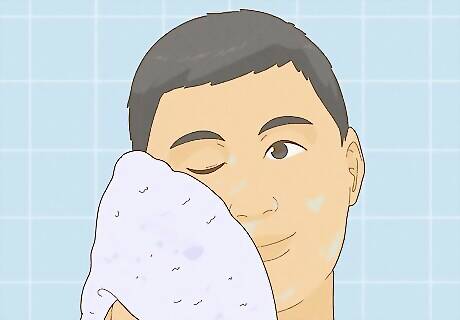
Pat your face dry. After you have rinsed all of the cleanser off of your face, use a clean, dry towel to pat your face dry. Do not rub the towel on your face because this may irritate your skin.
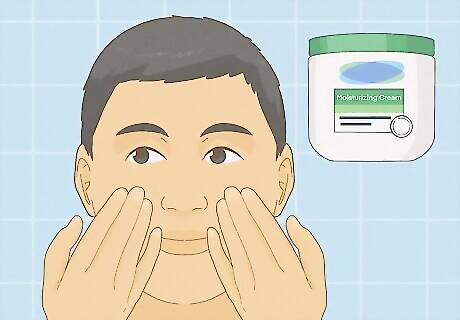
Apply moisturizer. Keeping your face moisturized will also help to keep it feeling smooth. Follow up your cleansing routine with a layer of moisturizer. Use a moisturizer that works with your skin type. For example, if you have oily skin, then choose an oil-free moisturizer. If you have dry skin, then choose a moisturizer that is meant for dry skin.
Using Special Treatments
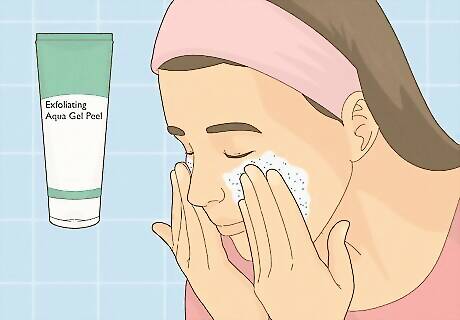
Use an exfoliating cleanser twice per week. Exfoliating can be helpful for some skin types. However, other skin types may be irritated by using an exfoliant too often. To prevent irritation from exfoliating, it is best to limit exfoliation to twice per week. Choose an exfoliating product that contains no more than 2% salicylic acid or 10% glycolic acid. Any higher than these levels and the exfoliating product may irritate your skin. Do not exfoliate if you have herpes simplex, warts, or molluscum contagiosum. This could lead to an infection. Avoid exfoliating if you are prone to dark spots from bug bites or burns. This is more common in people who have dark skin tones. If you have acne-prone skin, then you can exfoliate daily. Alternate between mechanical and chemical exfoliants from day to day. Mechanical exfoliants are made up of rough substances, such as corn cob meal silica, and date seeds. These also include loofahs and rough sponges. A chemical exfoliant breaks down the protein or bonds between cells using special ingredients.
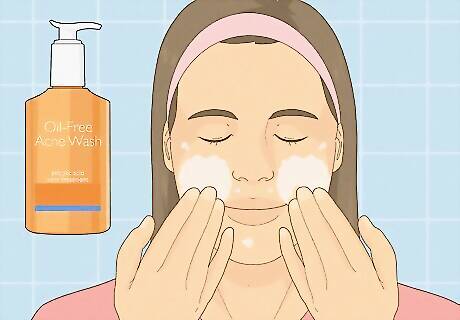
Try an acne fighting cleanser. If your skin is prone to breakouts, then using a product that contains over-the-counter acne medicine may be helpful. You can find cleansers and other products that include ingredients that may help to fight and prevent acne. Look for a product that contains salicylic acid, benzoyl peroxide, sulfur, or resorcinol. These products are available without a prescription. Keep in mind that it can take a month or more to see results from an over-the-counter acne treatment. You may also experience some redness and scaling as your skin adjusts to the medicine.
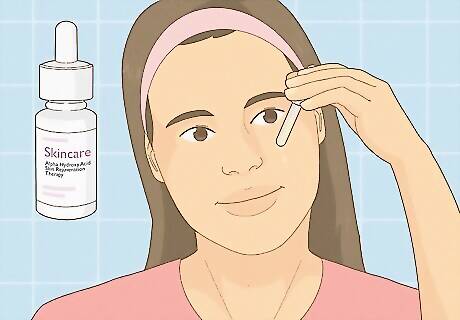
Look for products that contain alpha hydroxy acid. Products that contain alpha hydroxy acid may be helpful. Alpha hydroxy acid can help to remove dead skin cells and unclog pores, so it may result in smoother skin and also help to prevent acne. Look for a cleanser or moisturizer that contains alpha hydroxy acid.

Use a mask once per week. Masks that contain acne-fighting ingredients can help to reduce excess oils and bacteria on your skin. Look for a mask that contains charcoal or kaolin clay. Wash your face as usual and then apply the mask. Leave it on for about 10 minutes and then rinse it off with cool water and pat your skin dry with a clean towel. You can buy a mask or make your own.
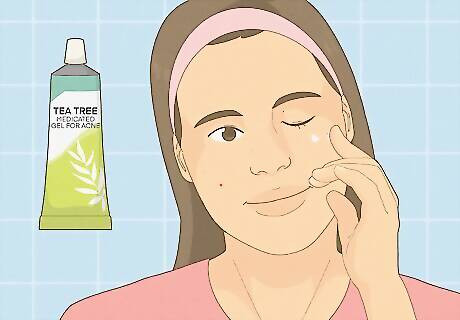
Try some tea tree oil gel. A 5% tea tree oil gel may be as effective as some over-the-counter acne medicines. If you want to try a natural alternative to benzoyl peroxide or another acne medicine, then tea tree oil might be worth trying. Do not apply the oil directly to your skin. Look for a lotion or gel that contains a 5% concentration of tea tree oil. Keep in mind that you may experience some side effects from using tea tree oil, such as irritation and redness.
Seeking Medical Help

See a dermatologist. If you continue to experience bumps on your skin from acne or other skin conditions, then see a dermatologist. A dermatologist can evaluate your skin and recommend a prescription or over-the-counter treatment. If you don’t know how to find a dermatologist, then you can ask your doctor for a referral.

Ask about prescription treatments for acne. There are several options for treating acne with prescription drugs. If your dermatologist thinks you need a prescription, then he or she may recommend: Retinoids. These are the most commonly recommended medicines for acne. Retinoid creams, lotions, and gels help to prevent your pores from clogging. Your dermatologist may also recommend Dapsone along with the retinoids to increase their effectiveness. Antibiotic creams or pills. Sometimes acnes can be so severe that it causes infections. When this happens, you may need a prescription antibiotic cream or pills to help the acne heal. Oral contraceptives. If you are female, then your doctor may recommend oral contraceptives to help control your acne. However, there are some serious potential side effects associated with taking oral contraceptives, so make sure that you ask your doctor about the risks before you decide if this treatment is right for you. Spironolactone. If oral contraceptives don’t work for you, then your doctor may recommend spironolactone (Aldactone). Isotretinoin. This is a last resort treatment because of the potentially serious side effects, but it can be an effective treatment if other treatments have not helped. However, due to the risk of birth defects, women of child-bearing age have to take a pregnancy test to receive this medication.
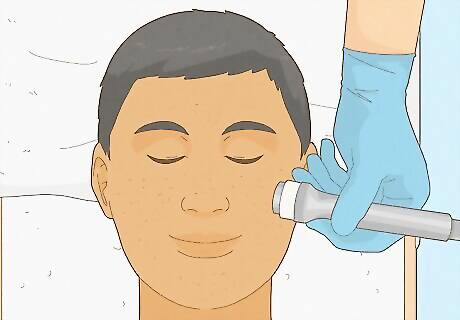
Find out about medical treatments for acne scars. Rough skin can also result from acne scars, but there are some treatments that may help. Some things you might ask your dermatologist about include: Dermabrasion. Dermabrasion can be an effective way to smooth out rough skin, especially if the roughness is from acne scars. It requires using a rotating brush to smooth out the surface of your skin. Ask your dermatologist about this option if your skin is rough from acne scars. Soft tissue fillers. Your doctor can also inject fat into pitted areas of your skin to smooth out the surface. However, the results are only temporary, so you would need to have this treatment done on a regular basis to maintain the results. Chemical peels. Peels can remove outer layers of skin and help to reduce the appearance of acne scars. Laser resurfacing and light therapy. These treatments use lasers to help even out your skin’s surface and improve its appearance. Skin graft surgery. For severe scars, a piece of skin can be surgically grafted onto your face. The results of this procedure are permanent, but the procedure is more serious than other treatments.

















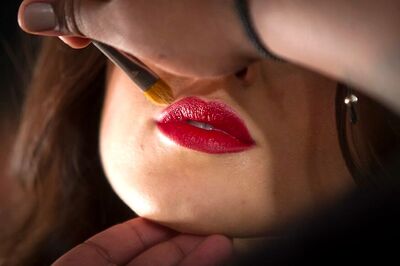


Comments
0 comment